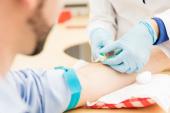Use of a Rapid, High-Sensitivity Troponin Protocol Doesn’t Boost 1-Year Outcomes
There were more downstream tests and some hints of harm, although one expert cautions this may have been chance.

For patients with suspected ACS and no clear signs of ischemia on ECG, use of a 0/1-hour high-sensitivity troponin T testing protocol in which all test results were available to treating physicians does not improve clinical outcomes compared with a conventional 0/3-hour protocol in which initially low troponin levels were masked, further results from the RAPID-TnT trial show.
The rapid protocol was associated with less functional testing and more coronary angiography and revascularization (as seen in an earlier report), but this did not translate into a difference in the 1-year rate of all-cause death or MI between the rapid and conventional testing arms (5.0% vs 3.8%; HR 1.32; 95% CI 0.95-1.83).
When the analysis was confined to the 92% of patients in the trial who had initial troponin levels in the “masked” range (≤ 29 ng/L), however, outcomes were worse in patients managed with the 0/1-hour protocol (3.7% vs 2.3%; HR 1.63; 95% CI 1.15-2.30).
The new data help to fill an evidence gap, since the improved diagnostic accuracy of these more-sensitive tests is already well established. What’s less clear is whether having better information on biomarker changes will lead to different use of additional tests and whether that, in turn, can improve patient outcomes.
Derek Chew, MBBS, PhD (Flinders University, Adelaide, Australia), who presented the findings Sunday during the virtual American College of Cardiology (ACC) 2021 Scientific Session, cautioned that this analysis should be considered exploratory since there was no significant difference in the overall trial cohort. The study was not powered to assess whether a specific change in management was associated with clinical outcomes, Chew noted, but “it does leave us to speculate” that changes in testing observed in the trial could explain the apparent outcome differences between trial arms.
“It does look like knowing modest elevations in troponin does drive up the use of coronary revascularization, and previous studies have shown that [use of] invasive strategies in those with low-level troponin elevations does not reduce death and myocardial infarction,” he said. “And then similarly, the shift away from functional testing might potentially also be exposing people to the residual risk of coronary events in this population of patients. So I think that we do need further studies that in a more-structured way evaluate functional testing and possibly [CT coronary angiography] in this group of patients.”
The study was published simultaneously online in Circulation.
The RAPID-TnT Trial
Use of high-sensitivity troponin assays has been shown to accurately rule out ACS in patients presenting to the emergency department, but the effect of such protocols on downstream clinical testing has not been well defined, Chew said. Moreover, he and his colleagues note in their paper, “no prospective randomized trials have demonstrated that the increased detection of myocardial injury associated with high-sensitivity troponin assays leads to a reduction in cardiovascular outcomes over the longer term.”
The 3,378-patient RAPID-TnT trial, conducted at four centers in South Australia, evaluated the impact of changes in care spurred by the introduction of a rapid, 0/1-hour testing protocol incorporating a fifth-generation high-sensitivity troponin T assay (Elecsys; Roche Diagnostics). Patients (median age 59 years; 47% women) were randomized to a 0/1-hour testing protocol in which physicians were provided with all high-sensitivity troponin T assay results (levels > 4 ng/L) or to a standard 0/3-hour protocol in which levels of 29 ng/L or less were masked to reflect the sensitivity of the earlier assay used. The goal was to assess the impact of giving physicians more information about troponin on management decisions and ultimately clinical outcomes.
An initial evaluation of the more-rapid protocol’s safety, reported in 2019, showed that patients managed with the 0/1-hour protocol were more likely to be discharged from the emergency department and spent less time there. The rate of functional testing was lower in the rapid arm, with numerical increases in rates of invasive coronary angiography and coronary revascularization; the latter differences reached significance in patients with troponin levels in the masked range. “This increase in early coronary investigations was associated with an overall increase in myocardial injury, without a commensurate increase in the diagnosis of type 1 MI (ie, atherosclerotic plaque disruption) at the initial presentation,” the authors note. Discharge using the 0/1-hour protocol was safe, with a negative predictive value for death/MI of 99.6%, Chew said.
At ACC 2021, Chew presented the second planned evaluation, looking at effectiveness of care informed by the 0/1-hour protocol and 12-month clinical outcomes. Over that longer follow-up, there was a numerical increase in invasive coronary angiography in the overall trial cohort (14.2% vs 12.4%; P = 0.013), with the difference reaching statistical significance in the subset of patients with troponin levels in the masked range (11.1% vs 8.3%; P = 0.01).
The difference in the rate of all-cause death/MI through 1 year between trial arms—favoring the 0/3-hour protocol—was significant only in the subset of patients with troponin levels in the masked range. A secondary outcome of unplanned hospital admissions for noncoronary CV diagnoses occurred at similar rates in both arms.
A Chance Finding?
Chew et al acknowledge that the increase in all-cause death/MI observed with the 0/1-hour protocol in the subset of patients with modest initial troponin levels could be a chance finding, considering the lack of a difference in the overall trial population. However, they note, the participants with initial troponin levels in the masked range “constituted over 90% of the study population and remained balanced between study arms for key clinical characteristics. Further, the persistent difference in adjusted analyses and the lack of difference in noncoronary cardiovascular events argues against, but does not exclude, a chance finding.”
But James Januzzi Jr, MD (Massachusetts General Hospital, Boston), supported the idea that the signal of harm indeed occurred by chance. “If one tries to find a logical explanation for this finding, the study results don’t provide one,” he commented to TCTMD. “For example, if we feel that mortality was increased because of diagnostic or therapeutic interventions made by clinicians seeing cardiac injury in patients, the investigators have not done an adequate job of providing evidence that that link exists. So to speculate would be dangerous, given the fact that a plausible counterfactual here is that this is a type 1 error in interpretation.”
Not only was the study limited by use of a “conventional” troponin level cutoff that was too low, Januzzi said, but also there are now studies—including one from his own group and another from a separate research team published earlier this month in the Journal of the American College of Cardiology—showing that implementation of high-sensitivity troponin testing is not associated with substantial increases in use of healthcare resources.
“So if the authors are speculating that their finding is on the basis of an increase in utilization, aggregate clinical data point very much away from this, and that leaves us therefore speculating—as they do in their discussion—that this may very well be nothing more than a chance finding,” Januzzi said. He added that if there were a risk associated with converting from a conventional to a high-sensitivity troponin assay, one would have expected to have seen it by now, especially considering the fact that more-sensitive assays have been in use for several years in many parts of the world.
Searching for the Best Management Approaches
Roxana Mehran, MD (Icahn School of Medicine at Mount Sinai, New York, NY), highlighted the uncertainty that still remains regarding use of high-sensitivity troponin assays following the results of the RAPID-TnT trial. “I think that this study adds once again to our understanding that perhaps we need to be a little bit more vigilant and better understand what these parameters mean, especially if there is early myocardial injury in a patient that is suspected for ischemia and presenting with typical symptoms,” Mehran explained.
To gain greater insights, further research is needed, she told TCTMD. “I don’t think this is a definitive study by any means. I think we just need to learn more.”
Deepak Bhatt, MD (Brigham and Women’s Hospital, Boston, MA), discussing the findings at a press briefing, agreed that the study underscores the uncertainty about what to do with patients who have elevated but relatively low levels of troponin. “There are a lot of those patients coming in, especially with current-generation troponin tests that are very sensitive, and it’s not entirely clear what to do with those sorts of values,” he said. “So I think this study really points to the need for further research and further refinement of exactly how we use troponins—in particular low levels of positive troponins—in our decision-making in the emergency department and in the subsequent care of these patients.”
For Januzzi, it’s necessary to emphasize that clinician education about correct use is crucial when any new technology is being introduced. In the case of high-sensitivity troponin testing, it should be made clear that an abnormal result “does not in and of itself equal myocardial infarction, so that clinicians do not then cascade into unnecessary diagnostic or therapeutic steps without thinking more broadly about the potential explanation for the abnormities in the test,” he said.
Todd Neale is the Associate News Editor for TCTMD and a Senior Medical Journalist. He got his start in journalism at …
Read Full BioSources
Lambrakis K, Papendick C, French JK, et al. Late outcomes of the RAPID-TnT RCT: a 0/1-hour high-sensitivity troponin T protocol in suspected ACS. Circulation. 2021;Epub ahead of print.
Disclosures
- Funding was provided by the National Health and Medical Research Council of Australia, with supplementary support from an unrestricted grant from Roche Diagnostics International.
- Chew reports speaker honoraria AstraZeneca Australia and Roche Diagnostics and unrestricted grants from Edwards Lifesciences and Roche Diagnostics.
- Januzzi reports grant support and consulting fees from Abbott, Roche Diagnostics, and Siemens.





Comments